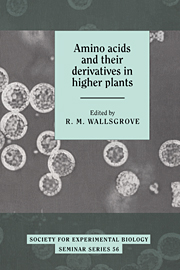Book contents
- Frontmatter
- Contents
- List of contributors
- Preface
- Glutamine synthetase in higher plants: molecular biology meets plant physiology
- Interactions of nitrogen and carbon metabolism: implications of PEP carboxylase and isocitrate dehydrogenase
- The genetics of aspartate derived amino acids in higher plants
- Oxidation of 1-aminocyclopropane-1-carboxylic acid (ACC) in the generation of ethylene by plants
- Regulation of carbon flow through the branched chain amino acid biosynthetic pathway
- Amino acid metabolism and protein deposition in the endosperm of wheat: synthesis of proline via ornithine
- The glycine decarboxylase complex in higher plant mitochondria: structure, function and biogenesis
- Glycine and serine synthesis in non-photosynthetic tissues
- Biogenesis of N-heterocydic amino acids by plants: mechanisms of biological significance
- Toxicity of non-protein amino acids from plants
- Processes involved in glutathione metabolism
- Betaines in higher plants – biosynthesis and role in stress metabolism
- Metabolism and function of polyamines during osmotically induced senescence in oat leaves and protoplasts
- Biosynthesis of cyanogenic glucosides. Elucidation of the pathway and characterization of the cytochromes P-450 involved
- The biosynthesis of glucosinolates in Brassicas
- Biochemical genetics of aliphatic glucosinolates in Brassica and Arabidopsis
- Index
Metabolism and function of polyamines during osmotically induced senescence in oat leaves and protoplasts
Published online by Cambridge University Press: 09 April 2010
- Frontmatter
- Contents
- List of contributors
- Preface
- Glutamine synthetase in higher plants: molecular biology meets plant physiology
- Interactions of nitrogen and carbon metabolism: implications of PEP carboxylase and isocitrate dehydrogenase
- The genetics of aspartate derived amino acids in higher plants
- Oxidation of 1-aminocyclopropane-1-carboxylic acid (ACC) in the generation of ethylene by plants
- Regulation of carbon flow through the branched chain amino acid biosynthetic pathway
- Amino acid metabolism and protein deposition in the endosperm of wheat: synthesis of proline via ornithine
- The glycine decarboxylase complex in higher plant mitochondria: structure, function and biogenesis
- Glycine and serine synthesis in non-photosynthetic tissues
- Biogenesis of N-heterocydic amino acids by plants: mechanisms of biological significance
- Toxicity of non-protein amino acids from plants
- Processes involved in glutathione metabolism
- Betaines in higher plants – biosynthesis and role in stress metabolism
- Metabolism and function of polyamines during osmotically induced senescence in oat leaves and protoplasts
- Biosynthesis of cyanogenic glucosides. Elucidation of the pathway and characterization of the cytochromes P-450 involved
- The biosynthesis of glucosinolates in Brassicas
- Biochemical genetics of aliphatic glucosinolates in Brassica and Arabidopsis
- Index
Summary
Introduction
Polyamines (PAs) are biologically ubiquitous aliphatic nitrogencontaining compounds of low molecular weight and polycationic nature. The diamine putrescine (Put) and the triamine spermidine (Spd) are probably synthesized by all organisms, while eukaryotes contain the tetraamine spermine (Spm) as well (Cohen, 1971).
In plants, PAs are metabolically related to the basic amino acids arginine and ornithine and therefore also to glutamic acid, a key intermediate in nitrogen metabolism (Tiburcio, Kaur-Sawhney & Galston, 1990). The biosynthetic and degradative pathways for the formation of Put, Spd and Spm in plants are now well established; the key enzymes have been characterized, but their regulation at molecular level is still obscure (Tiburcio et al, 1990; Galston & Tiburcio, 1991).
Suggested roles for PA function, and the evidence for these functions, has recently been reviewed (Tiburcio et al. 1993). These include membrane stabilization, free radical scavenging, effects on DNA, RNA and protein synthesis, effects on the activities of RNase, protease and other enzymes, the interaction with ethylene biosynthesis, and effects on second messengers. It was concluded that, in addition to interacting with plant hormones, PAs are able to modulate plant development through (a) fundamental mechanism(s) common to all living organisms (Tiburcio et al, 1993a).
This chapter deals with the study of PA metabolism and function during osmotically induced senescence in Avena sativa L. (oat) leaves and protoplasts.
- Type
- Chapter
- Information
- Amino Acids and their Derivatives in Higher Plants , pp. 205 - 226Publisher: Cambridge University PressPrint publication year: 1995
- 5
- Cited by



